| |
|
St
Botolph, Grimston
 |
|
It
is obvious, as you explore the little villages
south of the Sandringham estate, that there
really wasn't very much money around here in the
late medieval period. Further west and south,
churches were being rebuilt on a epic scale, the
largest structures to go up in west Norfolk
before or since. But to stand outside many of the
churches in this area is to revisit the intimate
scale of a couple of centuries before. Most
often, it is the tower which makes this
difference. But there are exceptions,
of course, and St Botolph is one of them. For
here in the late 15th Century the locals
bankrolled a great Perpendicular tower to match
the grandeur of their church in all its Early
English glory. It is more usual in East Anglia
for the tower to predate the church, and end up
looking uncomfortable, like a guest at a dinner
who knows he's about to be asked to leave. But
when the church predates the tower, the result is
most often an aesthetic pleasure, and here is
such a one at Grimston.
|
St Botolph
is different to many of its neighbours in another way,
because it is open to pilgrims and passing strangers
every day. They step through the 15th Century porch into
a big 13th and 14th Century church, fully aisled and
clerestoried, full of confidence.
One of the
delights of this church is one of the quirkiest sets of
late medieval bench ends in this part of Norfolk. Some of
them are on benches at the back of the church, some on
the return stalls in the chancel. The star of them is
probably the delightful mermaid, albeit rather restored,
and I was also very pleased to see the man in the stocks
with a pig on his back, presumably undergoing his
punishment for stealing it. Others include a man wrapped
in his blankets representing sloth, and a fox with a
goose, its neck in his mouth. There is also a haughty
cock, a jolly lion and what I take to be a rather gloomy
camel, a curiously beturbanned mythical beast, and a
lovely little inquisitive lion who appears to be peeping
around the choir stalls to see what is going on in the
sanctuary. One curiosity is a bench end of two figures,
one apparently attempting to twist the other's head off.
Not too far from here there are bench ends of
contortionists and wrestlers, so perhaps that is what is
represented here, a memory of some medieval travelling
fair.
 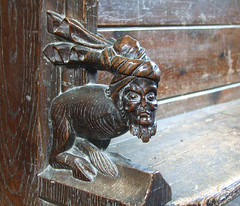 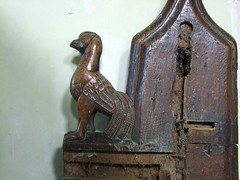 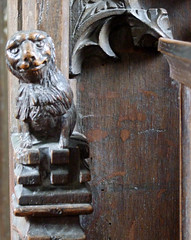  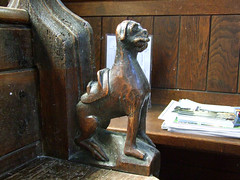    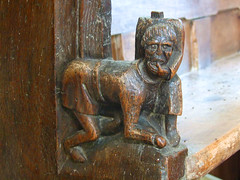
There is a
numinous quality to the light inside St Botolph, largely
a result of the extent to which the windows are filled
with clear glass, many of the quarries organised into
sober patterns. The light fills a church which is
confidently furnished and obviously very well-loved and
taken care of. I recalled what my friend the late Tom
Muckley would say about churches like this, that they
were seemly and fitting for Anglican worship.
| Not
all the glass is clear, for one window in the
south side of the chancel depicts an unusual
subject, the appearance of St Paul before Herod
Agrippa. Installed in 1851, the window is an
early work of the O'Connor brothers. In the
story, which is in the Acts of the Apostles, Paul
has appealed to Rome for justice after being
accused of heresy by Agrippa, who was King of
Judea. The Roman governor Festus, sympathetic to
Agrippa, suggests that a disputation between the
two in front of him might seal the verdict of
Paul's guilt. However, during the course of the
argument Paul converts Agrippa to Christianity. The scene
struck me, because quite by chance I had seen it
the previous day at Peterhouse chapel in
Cambridge, in 1850s glass ordered from a Munich
workshop. Perhaps the story was particularly in
the zeitgeist that decade, in which the first
great wave of the Oxford Movement began to roll
out across the sleepy Church of England.
|
|
 |
|
|
|
